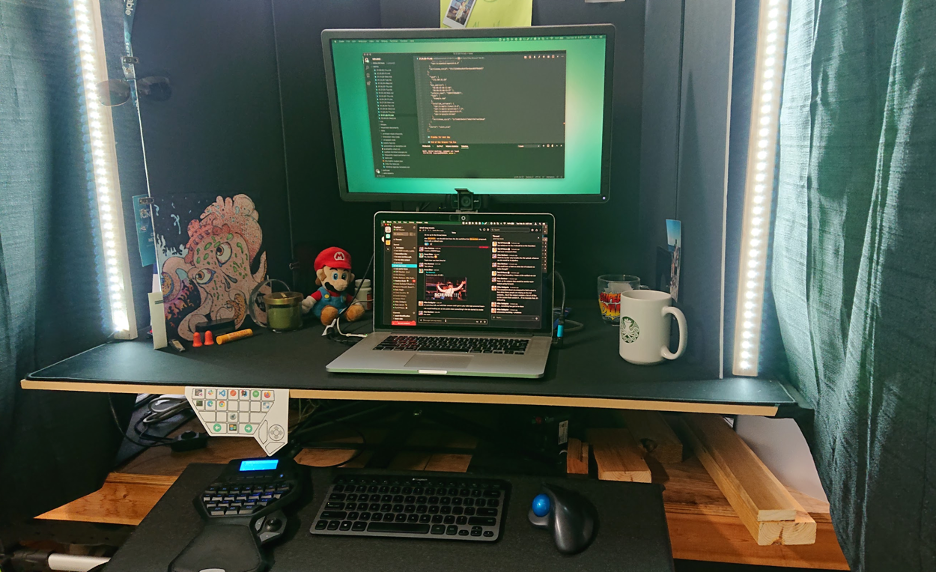Coding from Home: 6 Simple Hacks for Boosting Your Productivity

Working from home poses distinct challenges for engineers who rely on sustained periods of focus. Here are some survival tips from one of Tenable’s senior software engineers for staying productive in a busy household.
Tenable has embraced remote work culture for many years now. Most of the positive direction has come from our constant evaluation of work processes and iteratively improving over the years. With the advent of COVID-19, more and more companies are implementing optional or even mandatory work-from-home policies.
Since I've been with the Tenable engineering team for several years now and working from home the entire time, I've had the fortune of working with folks all over the world, from Ireland and Singapore to India and virtually every timezone across the U.S. and Canada. With that said, I’d like to share some valuable guidance for my fellow engineers who are now finding themselves navigating this new frontier of sequestered productivity.
Establish your work area
Try your hardest to set up a designated “office” area. This space, if possible, should not include any distracting devices or material, such as a TV, games, or even your favorite books. Consider setting up blinders, such as curtains or display boards, behind your work computer to block the sight of dirty laundry or dishes, anything that needs organizing and might cause you to think, "Oh, that'll only take five minutes. Let's knock it out." I can promise you that, most of the time, you’ll soon find yourself doing more than you originally planned.

I’ve set up my home office in the workshop behind my house. I’ll admit there are a couple of items that one might consider distracting – for example, the Mario plush toy. However, I’ve made an exception in this case since my daughter placed it there, and little tokens that remind me of my family and why I work so hard, in my opinion, don’t count as distractions.
It’s also important to limit background noise, especially loud non-rhythmic sounds, which can be detrimental to your focus. If you’re stuck working in an area like the kitchen (worst case scenario), try to avoid cranking the volume up too high on your headset. Save your hearing by using earplugs (not earbuds) and over-the-ear headphones. You can dull the sound with the earplugs and increase the volume on the headphones without harming your hearing. It's the best of both worlds.
Maintain a daily schedule
Working from home means you can lounge around all day in your pajamas while at the same time being a productivity powerhouse. Right? Well, maybe for some, but I've always found it better to adhere to a daily structure. I typically wake up by 6 a.m. to help get the kids ready for school (or, now, homeschooling). I enjoy a cup of coffee and try to do something – reading, meditating, going on a short walk – that doesn’t involve a computer. Then, I shower and get dressed for work, which helps get me into work mode. As a bonus, you'll look nice and professional on camera.
With more people working from home during the quarantine, it’s also imperative to align your schedule with other members of the household. For those of you with children, you must involve your partner, or if braving the perils of child-rearing on your own, speak to the kids directly. Others within your household need to know when you should be left alone to get your work done, and vice versa. Sharing work calendars with my wife has proven very helpful in this regard. While we can’t see the details of each other’s work events, we know the general blocks of time during which to limit interruptions.
Use timers to avoid rabbit holes
Most software engineers I know tend to be extremely persistent. We cannot stand to see a problem go unsolved once we start working on it. This can lead to us going “down the rabbit hole” fairly often, which can be a huge time sink if you’re working from home (and lucky enough to be free of distractions).
I’ve found a timer to be an effective hedge in this regard. When working on code or design, I typically set my Horo for Mac timer for 30 to 45 minute increments. Once it goes off, I check Slack and email messages for anything urgent or time-sensitive. These scheduled breaks replicate those interruptions that come naturally in a physical office, when a coworker might walk by your desk and ask what you’re up to. By temporarily breaking my train of thought, I can reflect from a higher level on what I’m doing and, more importantly, why I’m doing it.
Prioritize team channels over direct messages
In a physical office, a lot of communication happens effortlessly. You cross paths with a coworker in the hall or pass by their desk on the way to the kitchen. When working remotely, you need the discipline to keep that information flowing as often as you can to the right audiences.
When it comes to messaging channels like Slack, I’ve found that a direct message to someone is almost always an inferior communication pathway. Instead, use team chat rooms relentlessly (while tagging your target coworker) so that the whole team receives the benefits of your conversation. This is a far better emulation of a physical office setting. It allows others to easily provide insights you may not have even thought to ask about, and it shows everyone (including your manager) that you are actively engaged with work.
Your manager is the one person with whom to maintain a direct line. I’ve found it useful to update my manager at least once a day. You don’t have to be extremely detailed since you don’t want to encourage micromanaging. But it’s important to share the things you are currently working on and your progress on those tasks (especially unplanned ones). Without information on what you’re doing, your manager will have no way to balance the workload across the team or even offload some tasks onto another team entirely.
Set achievable goals for the next day
At the end of the workday, I look at what I’ve accomplished and then prioritize tasks for the next day. Pick one or two (or three, if you're brave) goals that you want to achieve. Doing this will motivate you to accomplish them for the simple satisfaction of marking them complete. I prefer doing this at the end of the day because it functions as a sort of "brain dump.” I can lay out what I hope to achieve the following day, along with summing up what has happened on the current day, then forget about it and go enjoy time with my family.
Since mornings with kids can be busy, I also use those evening hours to prepare certain things that can be done preemptively, which helps to lighten the morning load. This includes prepping the coffeemaker, making sure my clothes and the kids’ clothes are selected, the kids’ homework and school notices are fully attended to, and snacks are ready to go. I add to this list any time I find something new that can be done in the evening. Every little bit adds up to save a lot of time in the morning.
Find a way to transition into downtime
Since you no longer have a commute, going directly from your work area to your family can be a bit of a jolt. Try taking a brief walk or exercising right after work. You can also join a few coworkers for a virtual happy hour, which can help people loosen up and strengthen your team bonds. We’ve found online gaming to be an extremely helpful way to break the ice socially, and you don’t have to be a hardcore gamer to participate. There are plenty of online versions of traditional card and board games – from RISK and UNO to Texas Hold'em Poker and Ticket to Ride – that are fun and free to play, with a very low learning curve.
No matter what you choose, it’s important to find something that can help mark the boundary of the workday and transition your mental state into family time or simply relaxing in the evening. Everyone needs regular periods of mental rest, now more than ever, whether that’s playing with the kids, cooking together with your partner or simply watching TV.
As our daily routines become fraught with change and uncertainty, hopefully, these steps help add some structure and maintain a healthy separation between work and home, even as both increasingly occur under the same roof. Next time a moment of tension arises, try to reset your frame of mind and remember the unprecedented nature of this period. We'll get through this adventure together, and we may even pick up some better working (and living) habits along the way.
For more information on adapting your business during the challenging COVID-19 response, visit our Tenable resource page on protecting your remote workforce.
- Recruiting
- Remote Workforce

